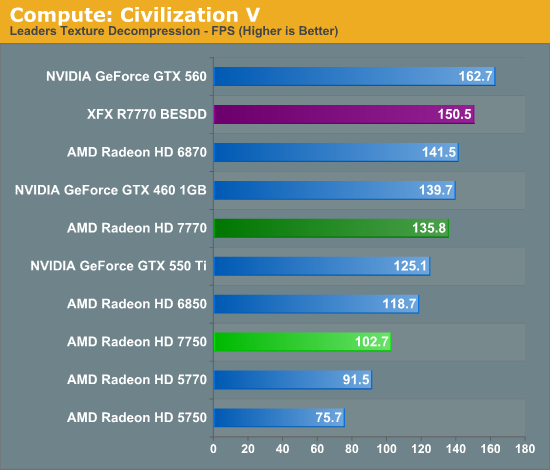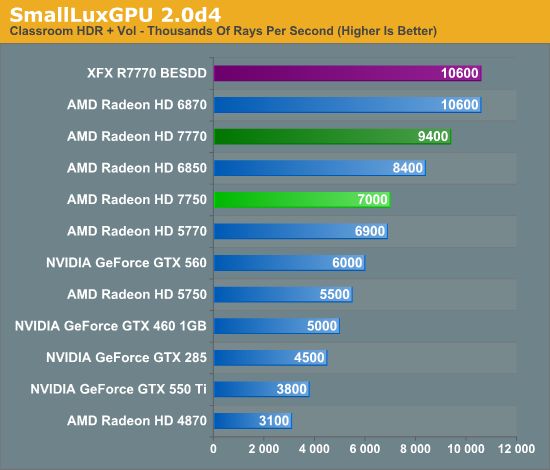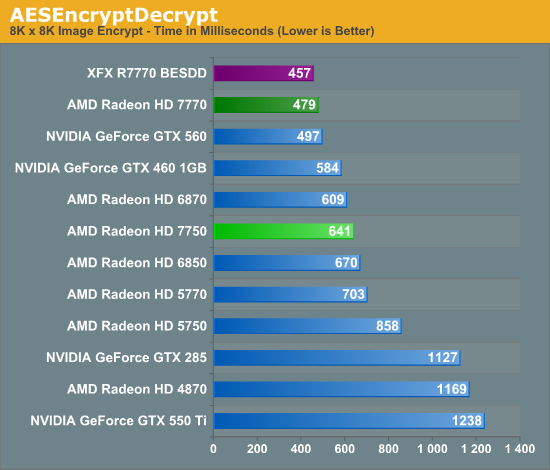AMD Radeon HD 7750 & Radeon HD 7770 GHz Edition Review: Evading The Price/Performance Curve
by Ryan Smith & Ganesh T S on February 15, 2012 12:01 AM EST- Posted in
- GPUs
- AMD
- HTPC
- GCN
- Radeon HD 7000
Compute Performance
Moving on from our look at gaming performance, we have our customary look at compute performance. With GCN AMD significantly overhauled their architecture in order to improve compute performance, as their long-run initiatives rely on GPU compute performance becoming far more important than it is today.
With such a move however AMD has to solve the chicken and the egg problem on their own, in this case by improving compute performance before there are really a large variety of applications ready to take advantage of it. As we’ll see AMD has certainly achieved that goal, but it raises the question of what was the tradeoff for that? We have some evidence that GCN is more efficient than VLIW5 on a per-shader basis even in games, but at the same time we can’t forget that AMD has gone from 800 SPs to 640 SPs in the move from Juniper to Cape Verde, in spite of a full node jump in fabrication technology. In the long run AMD will be better off, but I suspect we’re looking at that tradeoff today with the 7700 series.
Our first compute benchmark comes from Civilization V, which uses DirectCompute to decompress textures on the fly. Civ V includes a sub-benchmark that exclusively tests the speed of their texture decompression algorithm by repeatedly decompressing the textures required for one of the game’s leader scenes. Note that this is a DX11 DirectCompute benchmark.

Theoretically the 5770 has a 5% compute performance advantage over the 7770. In practice the 5770 doesn’t stand a chance. Even the much, much slower 7750 is ahead by 12%, meanwhile the 7770 is in a class of its own, competing with the likes of the 6870. The 7770 series still trails the GTX 560 to some degree, but once again we’re looking at the proof of just how much the GCN architecture has improved AMD’s compute performance.
Our next benchmark is SmallLuxGPU, the GPU ray tracing branch of the open source LuxRender renderer. We’re now using a development build from the version 2.0 branch, and we’ve moved on to a more complex scene that hopefully will provide a greater challenge to our GPUs.

SmallLuxGPU is another good showing for the GCN based 7700 series, with the 7770 once again moving well up the charts. This time it’s between the 6850 and 6870, and well, well ahead of the GTX 560 or any other NVIDIA video cards. Throwing in an overclock pushes things even farther, leading to the XFX BESDD tying the 6870 in this benchmark.
For our next benchmark we’re looking at AESEncryptDecrypt, an OpenCL AES encryption routine that AES encrypts/decrypts an 8K x 8K pixel square image file. The results of this benchmark are the average time to encrypt the image over a number of iterations of the AES cypher.

Under our AESEncryptDecrypt benchmark the 7770 does even better yet, this time taking the #2 spot and only losing to its overclocked self. PCIe 3.0 helps here, but as we’ve seen with the 7900 series there’s no replacement for a good compute architecture.
Finally, our last benchmark is once again looking at compute shader performance, this time through the Fluid simulation sample in the DirectX SDK. This program simulates the motion and interactions of a 16k particle fluid using a compute shader, with a choice of several different algorithms. In this case we’re using an (O)n^2 nearest neighbor method that is optimized by using shared memory to cache data.

It would appear we’ve saved the best for last, as in our fluid simulation benchmark the top three cards are all 7700 series cards. This benchmark strongly favors a well organized cache, leading to the 7700 series blowing past the 6800 series and never looking back. Even NVIDIA’s Fermi based video cards can’t keep up.










155 Comments
View All Comments
tipoo - Wednesday, February 15, 2012 - link
I probably won't be enticed into a video card upgrade until the next generation of Microsoft and Sony consoles are out. In the land of console ports, even a 6770 can run nearly everything comfortably at most common monitor resolutions.Movieman420 - Wednesday, February 15, 2012 - link
I have an OCd C2D Wolfdale running the 4850 and I also agree that the 4850 will go down as one of the best bang for the buck cards ever.My current i5/Z68 rig is running what I think will be considered another BBFTB card...the 6850...the dual fan Gigabyte 685OC in my case.
The 5770/6770/7770 are a fantastic line of mid-range cards...esp OCd but for a few $$ more an OCd 6850 still holds it's own quite well, there's no real counter for a 256bit vs 128bit memory bus. A big hats off tho to the 7770's high res numbers...pretty damn sweet, but I don't need uber res for a 23.5 inch monitor...ofc I'm not a hard core gamer either.
cjs150 - Wednesday, February 15, 2012 - link
7750 seems perfect for an HTPC. But to put it into context, IGPs should be using the 7750 as the benchmark for what to aim for. Can see this becoming completely obselete very soon once products based on Raspberry pi or Cu Box get released and match (the very impressive) picture quality of the 7750. In mean time get a low profile passive cooled version out and it will be perfect.As for the 7770 I simply see no purpose for it at all. NVidia 560 is only marginally more expensive and beats it completely. 7770 seems to me to be a complete waste of stock
Shadowmaster625 - Wednesday, February 15, 2012 - link
So the 7770 should be at $109, and that forces the 7750 down to $89 or less. The die sizes on these chips are a lot smaller than their competition so I dont see what AMD is thinking. Inflation? lol.Shadowmaster625 - Wednesday, February 15, 2012 - link
Why would a 7750 consumer 3 watts less than a 7770 during the "long idle" state. That really makes no sense. During that state there shouldnt be any difference at all between the two cards.tipoo - Wednesday, February 15, 2012 - link
It has over 100 more stream processors? 3W is pretty minuscule.akbo - Wednesday, February 15, 2012 - link
They are using a gorram 1200W PSU and those have s*** efficiency at 10% load. 3 watts means that it may pull about 1 watt more on-chip.KompuKare - Wednesday, February 15, 2012 - link
Which begs a simple question that has been bothering me with Anandtech GPU reviews for a while: how come they don't measure the wattage for the cards rather the whole system. Ok, it needs a custom PCI-E riser board and a multimeter but other sites (like techpowerup.com or this French site (can't think of it ATM) where the place I first saw that method used) manage it.Or at a minimum why is there no IGPU (Intel 3000) power usage in the review to act as a baseline?
Death666Angel - Wednesday, February 15, 2012 - link
I'm kinda disappointed by the 77xx launch. I'd have hoped for some €150 - €200 cards, consequently performing better than the 6870. Maybe the 78xx will be better. I really hope nVidia comes around with good cards, that way the consumer won't get ripped off. Although I also hope that AMD makes some money in the mean time.geniekid - Wednesday, February 15, 2012 - link
I just want to reiterate how much I appreciate the games you've chosen for your benchmarks. It's a very diverse set of games and covers a lot of the non-FPS genres that other review sites tend to leave out.